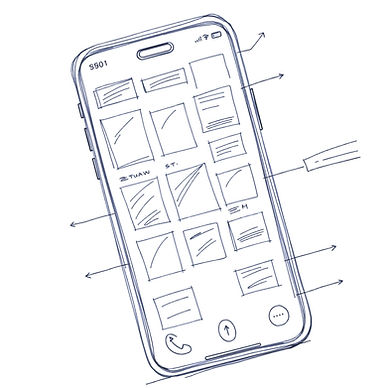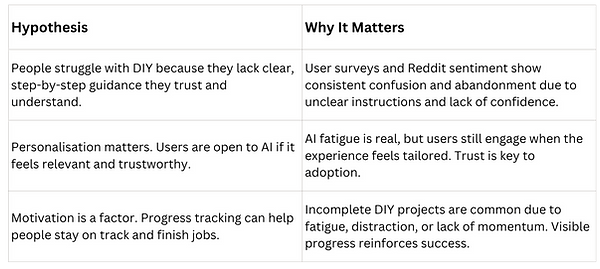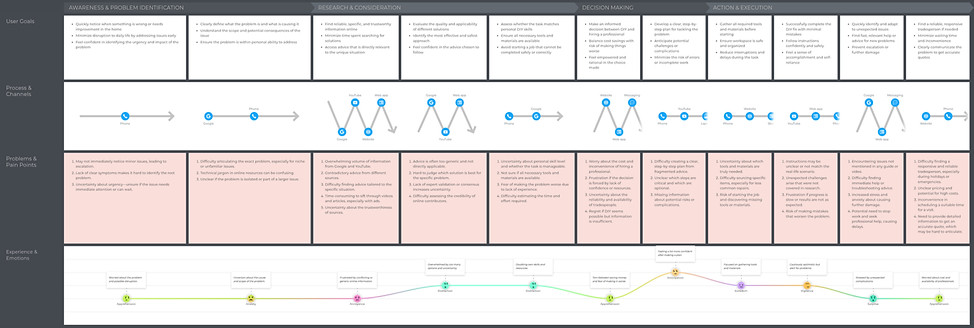MyHandyAI
Our vision is to fix everyday home problems using smart, AI-powered solutions

Overview

MyHandyAI is an AI-powered assistant that empowers homeowners and renters to confidently tackle home repairs and DIY projects, without needing professional help. The app delivers personalised, step-by-step guidance and dynamically generates tailored tool and material lists based on the user’s specific task, environment and inputs (e.g. voice, text, or photo).
By combining large language models with image recognition and contextual reasoning, MyHandyAI transforms fragmented DIY knowledge into a seamless, user-friendly experience: lowering barriers for novices, increasing task success rates and saving users money.
MyHandyAI
Snap. Solve. Save.
Customer Challenge
A recent UK survey found that nearly 5 million people worry about DIY errors. When they do occur, the average cost to fix is around £106 per incident, and people often make four missteps per year, leading to excessive repair bills or calling in professionals.
Why This Problem Matters
The DIY space is vast, yet deeply under-served.
-
$800 billion spent globally on DIY home improvement
-
$14.4 billion UK home improvement market
-
$11.7 billion UK DIY e-commerce revenue in 2024
Despite the scale of spending, many homeowners and renters feel stuck, anxious and overwhelmed before they even begin a project, as you can see from these Reddit quotes:
"Very frustrated with my lack of home improvement skills... I'm really disappointed in myself for not being [able] to do these simple projects..."
"Does anyone else feel completely overwhelmed by all the work your house needs... it gives me so much anxiety"
These emotional and confidence barriers lead to abandoned projects, tool returns and wasted time, revealing a Blue Ocean opportunity for guidance-first, personalised digital tools that solve unmet needs.
Hypotheses
Based on this initial research, I recorded the hypotheses I wanted to validate. Here are the top three:

Personas
Through Voice of the Customer interviews, I identified three distinct user personas representing different needs, behaviours and opportunity spaces. These personas helped drive feature prioritisation for our MVP by ensuring I focused on the most addressable and strategically valuable segment.
Persona 1: Liam, The Anxious Fixer

I prioritised Liam because he:
-
Represents a large and growing segment of millennials and Gen Zs moving into first-time homeownership or long-term renting
-
Is highly addressable through digital channels and open to AI-guided solutions
-
Most of Liam’s pain points: uncertainty, lack of tailored guidance, research fatigue, are directly solvable through MyHandyAI’s step-by-step, personalised experience
-
Provides early product validation and growth potential through referral and trust-based networks
Persona 2: Pat, The Confident DIYer

Why I deprioritised Pat:
-
Not actively seeking DIY guidance: unlikely to engage with a step-by-step support tool
-
More motivated by professional sourcing needs than personal task execution
-
Less responsive to digital channels, harder to acquire cost-effectively in MVP phase
Persona 3: Colin The Tradesman
While it's natural to focus on the most visible users of a product (the end customers) great product strategy requires looking at both sides of the ecosystem. For MyHandyAI, that meant not just understanding DIYers like Liam, but also listening to the service providers who might one day interact with or benefit from the platform.

Interviewing tradespeople like Colin was both exciting and validating. While they weren’t the core focus for MVP, their pain points revealed a clear opportunity for future product expansion:
-
The Virtual Tradesperson feature could allow skilled workers to offer paid remote guidance via MyHandyAI, enabling them to earn income from home during recovery or downtime.
-
By standardising how customers describe problems (via structured Q&A and photos), the app could significantly reduce time wasted on vague or inaccurate job requests.
While Colin’s use case showed strong potential for network effects and monetisation, I made the strategic decision to deprioritise this persona for MVP. Supporting tradespeople would require additional flows, service-tier logic, and legal considerations which are best addressed post-validation of core user demand.
However, Colin’s insights were powerful enough to shape the long-term roadmap and reinforce the broader vision for MyHandyAI: not just to empower DIYers but also to bridge the gap between consumers and professionals in a scalable, intelligent way.
Customer Journey
Journey Map
This journey map captures the end-to-end experience of our prioritised persona, Liam, navigating home repair and improvement tasks.
The insights reveal that while Liam strives for confidence, efficiency and minimal disruption, he frequently encounters friction, from unclear problem definitions and overwhelming online advice to challenges executing tasks and finding reliable tradespeople. Emotions fluctuate from anxiety and frustration to cautious optimism and eventual relief or regret, depending on the outcome.
This journey was instrumental in shaping features for MyHandyAI, such as tailored guidance, to meaningfully reduce friction and empower users.

Data-driven Feature Prioritisation
After exploring user pain points through qualitative Voice of the Customer interviews, I wanted to complement those deep insights with a broader, quantitative view. I returned to Reddit, where I’d first identified and sized the opportunity (as described in the Customer Challenge section) to find highly motivated DIYers who cared enough about their home repair frustrations to share their challenges and complete a detailed survey. To compliment this approach, I also stood outside a DIY store (B&Q) and asked shoppers if they would answer my short survey. Overall, I received >200 responses.
This approach helped ensure that MyHandyAI’s feature roadmap was grounded in both qualitative and quantitative user evidence. I plan to close the loop by returning to these same Reddit threads to test our MVP, using the platform not just as an insight engine, but also as a go-to-market funnel.
The survey data clearly supports the original premise: 78.5% of people surveyed said they would prefer to complete more home tasks themselves if they had better guidance (see donut plot). Additionally, 69.2% of responders were aged between 18-40 compared with only 29.5% over 40, supporting the decision to prioritise the Persona Liam, i.e. Gen Z and millennials.

Would you prefer to complete more home tasks yourself if you had better guidance?
Insight 1: People want bespoke help, as long as they trust the AI
"Smart repair suggestions based on my home, tools and skills" was rated an average of 7.6/10 for usefulness: one of the most valued features. Openness to AI scored 6.8/10 with polarity: some responses were enthusiastic, while others were against the use of AI.
Free text answers indicated trust would be built by:
-
Personalised answers
-
Proof of accuracy
-
Recommendations / reviews
-
Visuals (discussed next)
Features prioritised:
-
Let users skip or rephrase clarifying questions from the AI
-
Ask "why do you need this information?" and get an explanation
-
Receive personalised step-by-step instructions
-
Review the app at the end of the project

How would you prefer to interact with the app when diagnosing or working through home repair?
Insight 2: Visual guidance is non-negotiable
33.8% prefer to upload photos to explain their issues (vs. 31.2% preferring a combination, 20.8% preferring text and 14.3% preferring voice).
"Custom repair guides with images" scored an average of 7.3/10 for usefulness.
Visual-first was clearly a priority over voice inputs and even text.
Features prioritised:
-
Ability to upload a photo when describing the problem (User Story 4. Photo was prioritised over audio - see Schedule Risk and Mitigation Strategy)
-
Step-by-step instructions with visuals (Photos, gifs or videos) over long text (see User Story 8)
-
Post-completion survey (User Story 10)
Free text quotes:
-
"I would trust the AI if it was able to analyse photos of the problem really well"
-
"A proven record of accuracy"
-
"If an AI assistant allowed me to upload pictures it would make me trust it"
AI Model Selection and Model Input/Output
To ensure MyHandyAI delivers accurate, context-specific DIY guidance, we designed a multi-agent architecture built on state-of-the-art large language models (LLMs).
-
Model Selection Criteria
-
Performance: Ability to handle multimodal inputs (text, voice, images, video) with high accuracy.
-
Latency: Low response time to support an interactive, conversational experience.
-
Cost Efficiency: Balance between accuracy and compute cost for scalability.
-
Extensibility: Support for future AR guidance features and regional building code compliance.
-
Based on these criteria, our prototype leverages OpenAI GPT-5 family:
-
Nano models: Lightweight agents for fast validation and question suggestion.
-
Mini models: Mid-tier agents for summarisation, data extraction, and tool/material recommendations.
-
Full models: GPT-5 for complex, multi-step planning and reasoning.
Model Inputs:
User-submitted problem descriptions (text or speech-to-text)
Photos and videos of the repair site or object
Context metadata (room type, existing tools, skill level)
External reference content (YouTube tutorials, manufacturer manuals, Reddit forum posts)

Model Outputs:
Concise problem summaries
Recommended tools and materials (with affiliate links)
Bespoke, step-by-step repair guides
Cost and time estimates
Safety guidance and risk warnings
Links to most relevant video or product resources
Data Strategy and Data Pipeline

I created a data strategy that ensures the AI receives high-quality, contextually relevant input while maintaining user privacy and compliance.
-
Data Sources:
-
External: YouTube API, Reddit API, Google Custom Search, manufacturer manuals.
-
Internal: User-uploaded photos/videos, voice notes, and project descriptions.
-
-
Ingestion Frequency:
-
External sources scraped weekly to maintain freshness.
-
User data ingested event-based at project submission.
-
-
Processing Pipeline:
-
Scraping & Parsing: APIs fetch raw content, which is cleaned and filtered.
-
Embedding Generation: Processed content is vectorised and stored in Qdrant for fast retrieval.
-
Metadata Tagging: Tools, materials, project type, safety factors and risk metadata added.
-
Vector Search & RAG: Retrieval-Augmented Generation combines relevant external and internal data before LLM processing.
-
Duplication & Quality Checks: Hallucination agent and content validation routines verify feasibility and accuracy.
-
AI Model Validation

Accuracy and safety are critical for MyHandyAI’s credibility and user trust. We employ multi-layer validation:
-
Hallucination Agent: Reviews all generated recommendations for factual grounding and feasibility.
-
Match Validation Agent: Confirms that recommended videos, tools, or materials are relevant to the specific problem context.
-
Question Validation Agent: Ensures clarifying questions are clear, relevant, and answerable.
-
User Testing Feedback Loop: Post MVP, users can flag unclear or incorrect steps; this feedback is logged and used to fine-tune prompts and retrain models.
-
Human In the Loop: Post MVP, AI outputs are compared against expert tradesman instructions for accuracy scoring.
Product Roadmap
The Product Roadmap is split into four stages:
-
MVP: The minimum features required to address our priority persona, Liam's pain points
-
Post MVP: Focus on richer data input, better accuracy and verification features
-
Growth: Expand capabilities to include human expertise and custom AI-generated video content for step-by-step instructions
-
Scale: Add features that create network value and long-term retention
%20Core%20AI%20DIY%20Assistance.png)
User Stories and Acceptance Criteria
Home Page

Describing the project

Clarifying Questions



Tools and Materials List

Step-by-step Guidance

Post-completion Survey

Overall Usability

Risks and Remediations
Risk Type
Description
Why It's a Risk
Mitigation Strategy
Schedule Risk
Broad scope with multiple input modes, LLM, media integration, and tailored instructions
Multiple AI-powered and multimodal features increase engineering and testing complexity.
Finalise a strict MVP acceptance test: “The app shall allow users to complete two core tasks: hang a mirror and fix a broken toilet, using text, image or voice input. It must return step-by-step guidance and tool suggestions for both tasks.”
Maintain agile scope flexibility, allowing audio input and advanced AI explanations to be de-prioritised if not production-ready.
Budget Risk
Post-launch LLM, image analysis, and cloud hosting costs may be unpredictable.
Users say they’ll only pay if the app is faster and more complete than current online research. This depends heavily on LLM/API quality.
Create a cost forecast model using assumptions for:
DAUs (Daily Active Users) ;
Avg prompts/user/session ;
API unit cost for LLM, photo, audio, hosting.
Example: [DAUs] x [Avg sessions/day] x [LLM prompts/session] x [cost/prompt].
Explore LLM cost reduction strategies: Prompt tuning, Caching responses, Hybrid model usage (e.g. open-source model for generic queries, commercial model for critical steps).
Operational Risk
Lack of prioritisation discipline could lead to overbuilding or incomplete flow at MVP.
Without laser focus, MVP could ship with impressive features but fail to validate the core value.
Lock-in MVP success criteria (above).
Assign a PM to enforce trade-offs in sprint planning.
Technical Risk
Integration across multiple services (LLM, image/audio analysis, Amazon APIs); GDPR exposure.
Missteps could create feature delays, failure points or non-compliance.
Start with manual fallbacks if AI analysis fails (e.g. allow “I don't know” responses with default advice).
Add GDPR consent checkbox on first use.
Programmatic Risk
No legal team to review disclaimers or safety policies.
Legal exposure if users are injured or damage property following app instructions.
Draft and publish a clear disclaimer: “Use at your own risk. Always follow safety precautions and local building regulations.”
Display disclaimers in context (e.g. before showing high-risk steps).
Business Risk
Low adoption if MVP doesn’t outperform Google/YouTube or lacks trust.
Users will only pay if guidance is faster, clearer, and more trustworthy than existing alternatives.
Prioritise LLM, prompt and context design to maximise answer clarity and task relevance.
Test guidance vs. YouTube for the two MVP use cases.
Include “Why this step/tool?” explanations to build user trust.
Launch with a targeted GTM strategy:
Beta waitlist for DIYers via Reddit, Pinterest, Facebook DIY groups
Influencer outreach to micro-creators in home repair
Launch on Product Hunt + Reddit DIY on same day
User Testing Risk
No Task-Based or Post-MVP launch user testing plan yet in place.
Could ship with poor UX or fail to validate real user behaviour.
Run a 3-phase test strategy:
Exploratory Testing (July 29-July 30, complete): 3–5 users validating flows
Task-Based Testing (Aug 6–15): Observe users trying mirror + toilet tasks
Post-MVP Feedback Loop (Aug 20+): In-app feedback button + 5-min post-project survey
Business Model
To encourage broad adoption while maintaining a path to monetisation, the pricing strategy follows a freemium-to-premium model:
-
Free Tier
-
Premium Trial: All new users get 1 month of Premium features to experience full value.
-
After 1 month, downgrade to Basic Tier.
-
Text input only
-
Limited project history
-
No voice / photo features
-
Limited to one project / month
-
-
DIY Enthusiast Tier £4.99 / month
-
Unlimited DIY projects
-
Voice / photo / text interface
-
Save and track project history
-
Early access to new features
-
-
Affiliate Revenue Stream
-
Commission from recommended tools and materials
-
Brand partnerships with hardware retailers
-
Future Considerations:
-
Pro Tier (for Tradespeople) £14.99 / month
-
Unlimited escalations from users
-
Verified professional profile and ratings
-
Priority listings
-
Access to lead dashboards and insights
-

System Architecture

